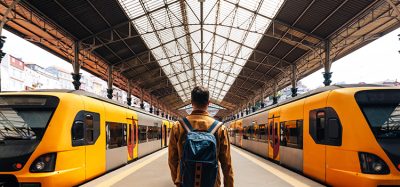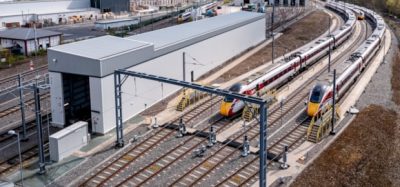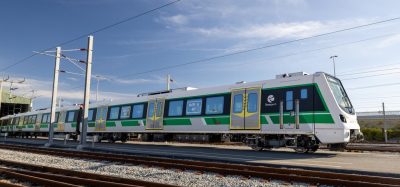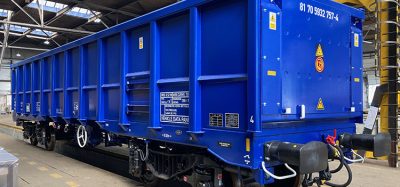The EURO 4000: powerful, flexible and efficient
Posted: 15 September 2006 | | No comments yet
What is currently Europe’s most powerful diesel-electric locomotive is being presented by Vossloh Transportation Systems for the first time at InnoTrans 2006. Built by Valencia-based Vossloh España, the EURO 4000 is powered by a 16-cylinder two-stroke 3,178-kW engine from Electro-Motive Diesel Inc. (EMD), USA.
What is currently Europe’s most powerful diesel-electric locomotive is being presented by Vossloh Transportation Systems for the first time at InnoTrans 2006. Built by Valencia-based Vossloh España, the EURO 4000 is powered by a 16-cylinder two-stroke 3,178-kW engine from Electro-Motive Diesel Inc. (EMD), USA.
What is currently Europe’s most powerful diesel-electric locomotive is being presented by Vossloh Transportation Systems for the first time at InnoTrans 2006. Built by Valencia-based Vossloh España, the EURO 4000 is powered by a 16-cylinder two-stroke 3,178-kW engine from Electro-Motive Diesel Inc. (EMD), USA.
Flexibility, power and efficiency – these are the criteria to which the new locomotive has been engineered. Available in options for passenger or goods haulage, the EURO 4000 will operate on both national and international routes since it modifies to match all European signal systems. It is also fully fitted with the European Train Control System (ETCS). The associated homologation work will soon be completed. It is precisely this European cross-border traffic that is to become the main field of application for the EURO 4000, enabling rail operators to exploit electrified and non-electrified routes without having to change locomotives.
Sustained strong demand for diesel traction
The EURO 4000 is the top model of a multi-faceted range of diesel-electric locomotives from Vossloh Transportation Systems. Extensive market studies formed the basis of the new design: research conducted by the Combined Transport department of UIC CGT (Union Internationale des Sociétés de Transport Combiné Rail-Route) have shown that haulage volumes on European rail routes are expected to advance by 113% in the period between 2002 and 2015. This growth is accounted for to a large extent by the ‘regain’ of goods originally carried by rail and then switching to trucks and now attracted by efficient and ecological rail services. However, the encouraging trend is overshadowed by the fear expressed by the study that in the years ahead many of the most important rail links in Europe will be gradually congested. What’s more, rail traffic must become more effective in terms of capacity and energy consumption. Within this context, rail infrastructure management is playing an ever important role, its overriding goal being to abate or even eliminate rail traffic tailbacks with the aid of slots for specific services and suppliers and improved timetables. Another outcome of the study especially important to rolling stock manufacturers is the trend whereby goods vehicles tend to be loaded to the limits of their capacity, with a resultant rise in average tonnage per train. As a consequence, trains are getting to be longer. The UIC CGT researchers arrive at the conclusion that the trains of tomorrow will be required to perform their services in shorter and shorter times and this presupposes a larger number of higher-duty locomotives.
Vossloh’s own market research in preparation for the EURO 4000 has shown that the electrification of major routes in Europe is not at all as advanced as often claimed. Throughout Germany, for instance, only 42% of all rail links are ‘wired up’, and in the Czech Republic the figure is only about 30%. Vossloh Transportation Systems has concluded from this that strong demand for diesel traction will therefore continue in European rail transport. Against this background, the EURO 4000 is designed exclusively for the needs of the European rail market, and there are no plans to export it to the American or Asian markets for the time being. Although these countries do operate a large share of diesel-powered locomotives, the operating parameters are very different from Europe’s, hence the rarity of American diesel locomotives in Europe.
At the concept stage for the EURO 4000, the focus was on two customer groups. State-run or formerly state-run European railway operators often have large fleets of, in most cases, diesel-hydraulic locomotives. However, these are outdated with high breakdown rates and low efficiency. The EURO 4000 is intended as a sophisticated replacement. A second important target group is the growing mass of private-sector rail operators that are establishing themselves increasingly, even in international transport. An example of this is the hinterland traffic flows (block train routes) from the North Sea ports extending well into the countries of Eastern Europe.
In order to specify the new EURO 4000 as closely as possible to the requirements of rail operators (the future customers) Vossloh had interviewed them closely: reliability, low running costs, compliance with all EU regulations regarding exhaust and noise, crash behavior, and certification for cross-border operation – these were at the top of the ‘wish list’. Then came a comfortable, ergonomic working environment for the engineer, flexible deployment options, and plenty of power. From these studies and interviews Vossloh then drew up its specifications menu for the new EURO 4000: the aim was to develop a six-axle, diesel-electric locomotive able to move maximum loads at maximum speed at lowest operating costs – with maximum cross-border action radius.
The outcome of this extensive market research is the EURO 4000: a locomotive available in options for passenger or goods haulage. The freight versions of the EURO 4000 are first of all destined for France, Germany, Belgium, and The Netherlands. Later to be followed by Spain (re-gauged) and Scandinavia.
Proficiency through partnership
The EURO 4000 has been engineered by Vossloh Motive Power, Europe’s biggest diesel locomotive manufacturer, in close cooperation with Electro-Motive Diesel Inc. (EMD) in the USA. Formerly General Motors’ electromotive division, EMD is the world’s most successful producer of diesel-electric locomotives, with approximately 58,000 units supplied to date. The traction unit installed in the EURO 4000 is based on proven systems that EMD has supplied in large numbers to North American rail operators such as Union Pacific, Norfolk Southern and Burlington Northern Santa Fe, to name but a few. Vossloh’s Spanish production plant and EMD have been working together for some 50 years now in the area of rail vehicle traction systems and the fruits of this liaison can be seen running on tracks in Israel, Britain, the USA, and elsewhere.
Hauling heavy and long trains
With its high-duty traction system, the EURO 4000 has been designed mainly for hauling very heavy and/or very long trains. It is powered by a turbocharged 16-cylinder two-stroke V-type diesel engine with an output of 3,178 kW. The engine is a medium-speed high-duty engine with uniflow scavenging specially engineered by EMD for locomotive traction. The engine comes from a family of which over 7,000 members have been built since 1985. A top speed of 120km/h for freight transport allows operation even on heavily frequented lines. Thanks to its fuel-efficient electronic diesel injection and ample tank capacity (7,000 liters), the 123-t EURO 4000 (axle load 20.5 t, axle arrangement CoCo) can cover distances of up to 2,000km without having to refuel. Higher top speed can be reached with the passenger version, 160km/h, with a slight increase of weight of this version (126 t).
State-of-the-art communications and GPS systems allow the locomotive’s position to be located at any time. An optional GSM data transmission system delivers en route all the relevant vehicle data to the maintenance shop, thus minimising the risk of unscheduled stops. This diesel-electric locomotive is also remarkable for its low noise level and extended service/maintenance intervals. In all, service-friendliness has been of major importance in the design of this locomotive built from modular and standardised parts in order to ease any repair or replacement work. Oversized components ensure extended service-life and low upkeep costs. What’s more, Vossloh Transportation Systems guarantees parts availability throughout the service life of the EURO 4000.
The exhaust gas values are lower than the current EU ceilings. This high-duty locomotive naturally complies with all other European noise, crash and fire-protection codes and standards. In the design of the EURO 4000 Vossloh has emphasised in particular the engineer’s working environment. The two very spacious stands are ergonomically engineered for best possible working conditions, offer excellent visibility and are separately fully air conditioned. Noise and vibrations are effectively absorbed. The design complies with EN 12663, UIC 651, and DIN 5566. The shock-resistant front shield not only enhances engineer safety, it also minimises cab noise while acting as a fire-protection component according to DIN 5510. In the event of collision, engineer and locomotive are effectively protected by the integrated anti-crash system pr EN 15227. Additionally, the EURO 4000 complies with UIC 518 standards regarding rail stress, safety, and performance as well as with the EN 12299 comfort and convenience requirements.
Even if the EURO 4000 is only celebrating its premiere at InnoTrans 2006 in Berlin, promising talks with rail operators are already underway and reflect the huge interest that Vossloh Transportation Systems has stimulated with its new locomotive. The maximum output of the plant in Valencia – depending on capacity utilization for the construction of light railcars – is about six EURO 4000s per month.
Summary
Vossloh Transportation Systems’ EURO 4000 is currently Europe’s most powerful diesel-electric locomotive and suitable for both rapid and high-duty passenger and goods haulage. In the design of the vehicle, Vossloh attached particular value to flexibility of use and productivity (diesel engine with 3,178 kW) plus efficiency and low operating costs.







